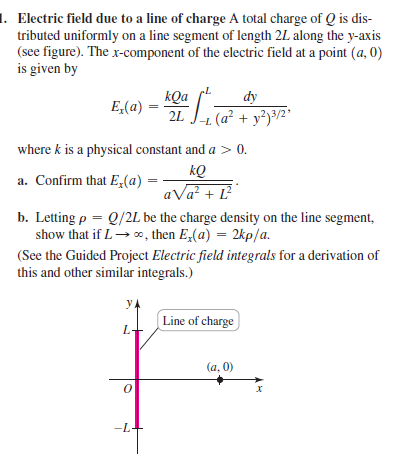1. Electric field due to a line of charge A total charge of Q is dis- tributed uniformly on a line segment of length 2L along the y-axis (see figure). The x-component of the electric field at a point (a, 0) is given by kQa dy E,(a) %3D 2L (a² + y?j³/2° where k is a physical constant and a > 0. kQ aVa? + L? b. Letting p = Q/2L be the charge density on the line segment, show that if L→ 0, then E-(a) = 2kp/a. a. Confirm that E,(a) (See the Guided Project Electric field integrals for a derivation of this and other similar integrals.) y. Line of charge (а, 0) -L+
1. Electric field due to a line of charge A total charge of Q is dis- tributed uniformly on a line segment of length 2L along the y-axis (see figure). The x-component of the electric field at a point (a, 0) is given by kQa dy E,(a) %3D 2L (a² + y?j³/2° where k is a physical constant and a > 0. kQ aVa? + L? b. Letting p = Q/2L be the charge density on the line segment, show that if L→ 0, then E-(a) = 2kp/a. a. Confirm that E,(a) (See the Guided Project Electric field integrals for a derivation of this and other similar integrals.) y. Line of charge (а, 0) -L+
Principles of Physics: A Calculus-Based Text
5th Edition
ISBN:9781133104261
Author:Raymond A. Serway, John W. Jewett
Publisher:Raymond A. Serway, John W. Jewett
Chapter19: Electric Forces And Electric Fields
Section: Chapter Questions
Problem 52P: A cylindrical shell of radius 7.00 cm and length 2.40 m has its charge uniformly distributed on its...
Related questions
Question

Transcribed Image Text:1. Electric field due to a line of charge A total charge of Q is dis-
tributed uniformly on a line segment of length 2L along the y-axis
(see figure). The x-component of the electric field at a point (a, 0)
is given by
kQa
dy
E,(a)
%3D
2L
(a² + y?j³/2°
where k is a physical constant and a > 0.
kQ
aVa? + L?
b. Letting p = Q/2L be the charge density on the line segment,
show that if L→ 0, then E-(a) = 2kp/a.
a. Confirm that E,(a)
(See the Guided Project Electric field integrals for a derivation of
this and other similar integrals.)
y.
Line of charge
(а, 0)
-L+
Expert Solution
This question has been solved!
Explore an expertly crafted, step-by-step solution for a thorough understanding of key concepts.
This is a popular solution!
Trending now
This is a popular solution!
Step by step
Solved in 2 steps

Recommended textbooks for you

Principles of Physics: A Calculus-Based Text
Physics
ISBN:
9781133104261
Author:
Raymond A. Serway, John W. Jewett
Publisher:
Cengage Learning

Physics for Scientists and Engineers with Modern …
Physics
ISBN:
9781337553292
Author:
Raymond A. Serway, John W. Jewett
Publisher:
Cengage Learning

Physics for Scientists and Engineers, Technology …
Physics
ISBN:
9781305116399
Author:
Raymond A. Serway, John W. Jewett
Publisher:
Cengage Learning

Principles of Physics: A Calculus-Based Text
Physics
ISBN:
9781133104261
Author:
Raymond A. Serway, John W. Jewett
Publisher:
Cengage Learning

Physics for Scientists and Engineers with Modern …
Physics
ISBN:
9781337553292
Author:
Raymond A. Serway, John W. Jewett
Publisher:
Cengage Learning

Physics for Scientists and Engineers, Technology …
Physics
ISBN:
9781305116399
Author:
Raymond A. Serway, John W. Jewett
Publisher:
Cengage Learning

Physics for Scientists and Engineers
Physics
ISBN:
9781337553278
Author:
Raymond A. Serway, John W. Jewett
Publisher:
Cengage Learning

College Physics
Physics
ISBN:
9781285737027
Author:
Raymond A. Serway, Chris Vuille
Publisher:
Cengage Learning

College Physics
Physics
ISBN:
9781305952300
Author:
Raymond A. Serway, Chris Vuille
Publisher:
Cengage Learning